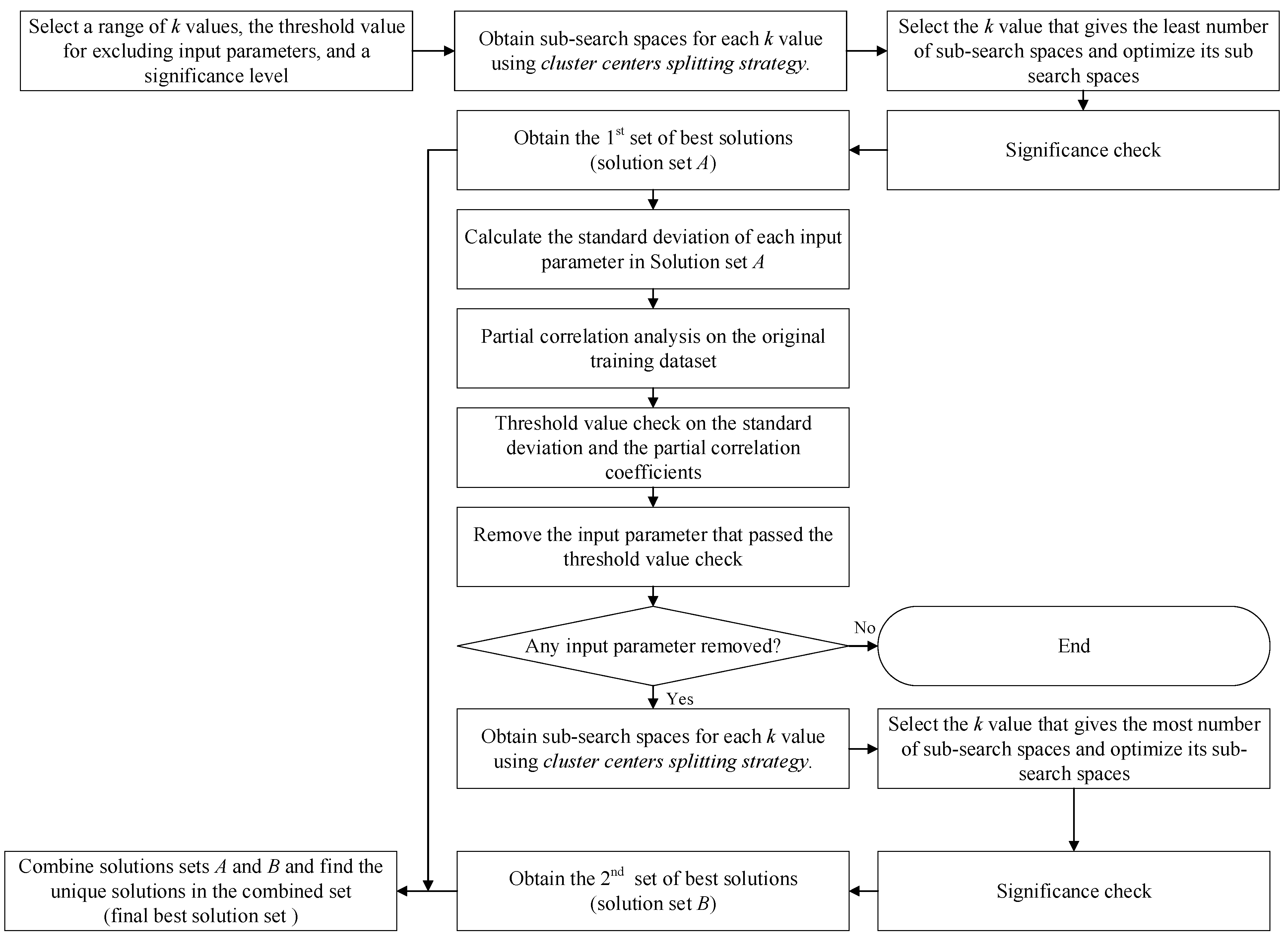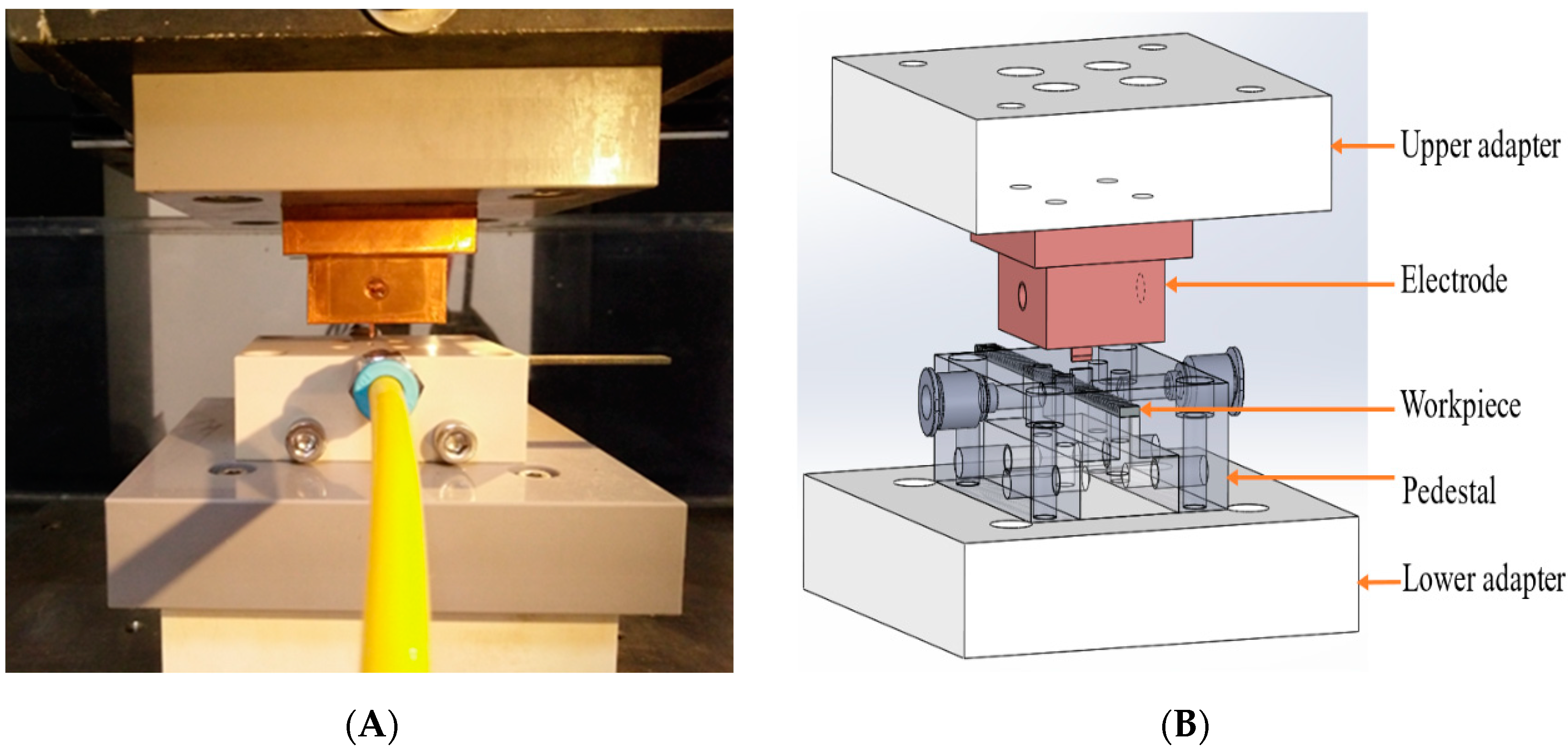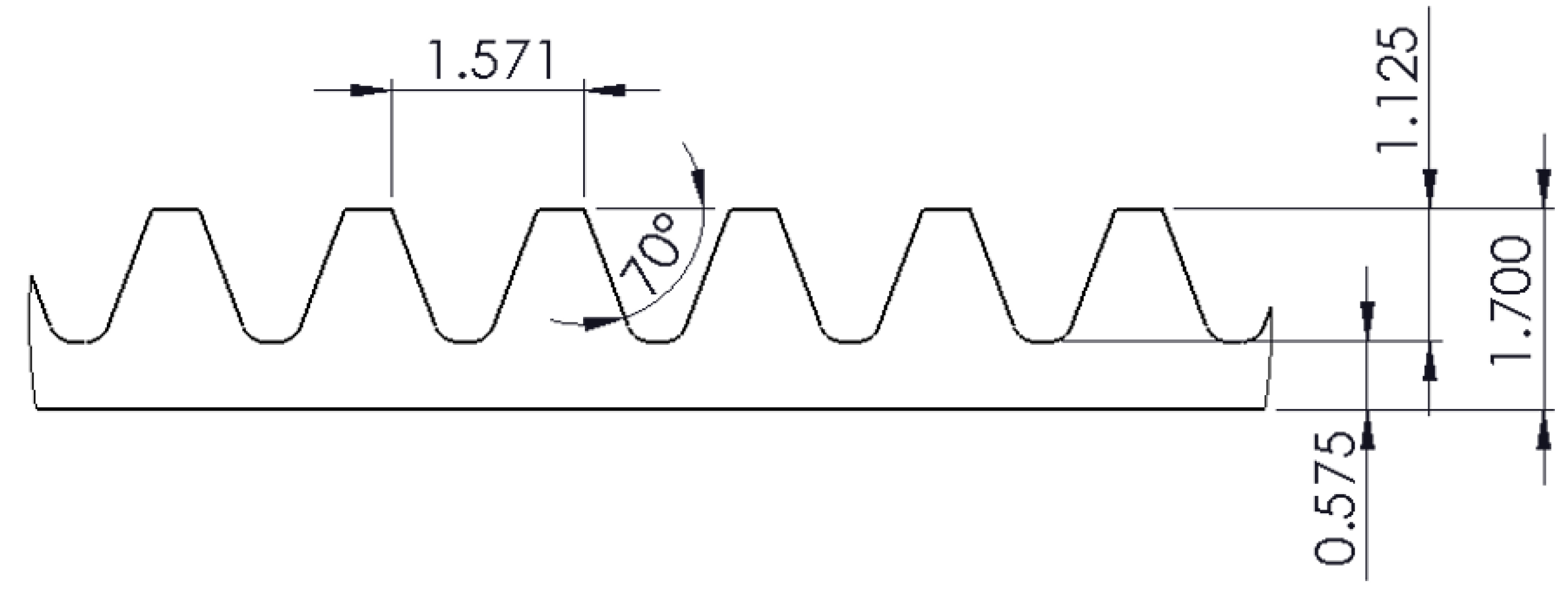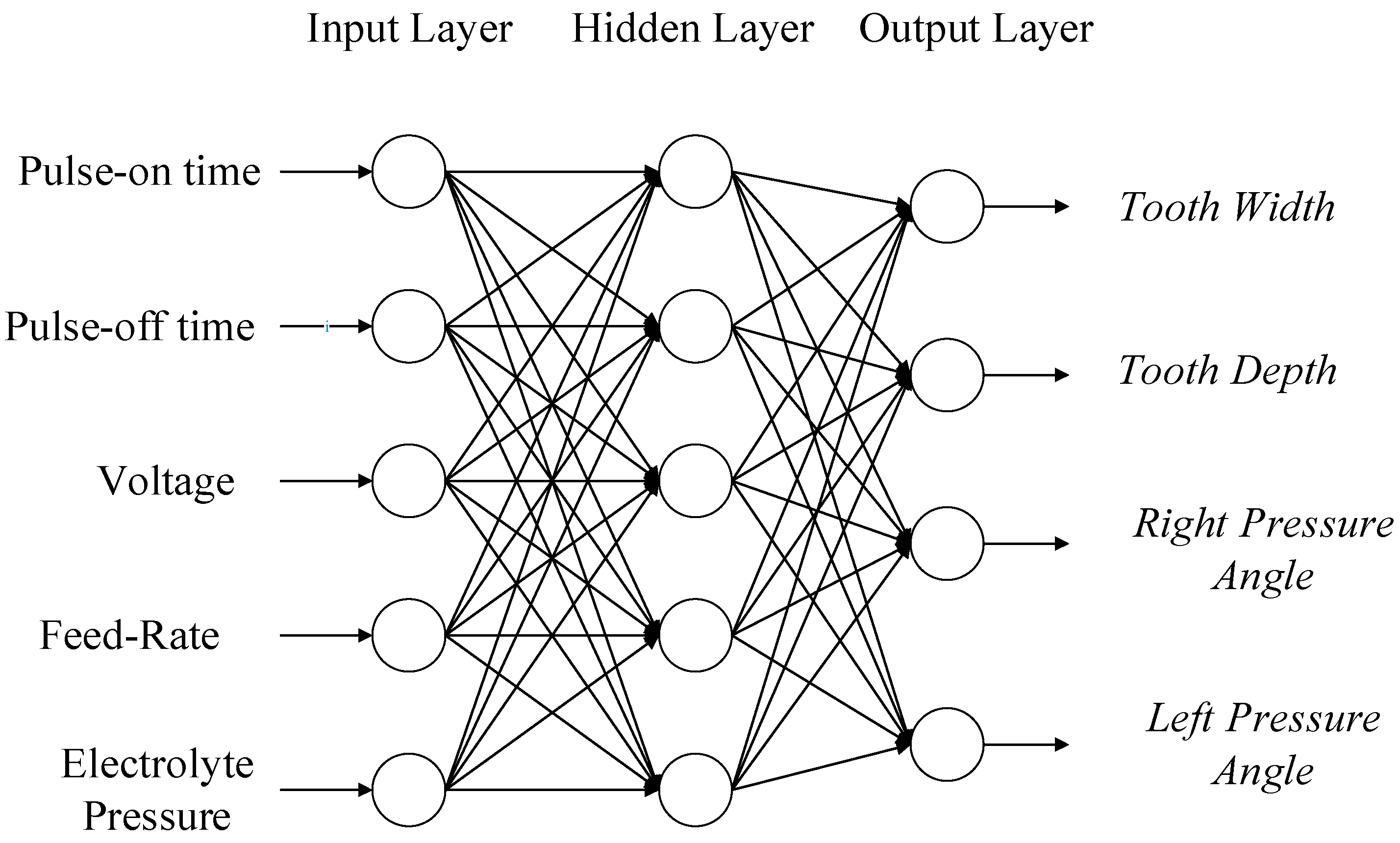A Two-Stage Filter Split-Optimization Approach for Obtaining Multiple Solutions with Identical Objective Value
Abstract
1. Introduction
2. Literature Review
3. Description of Methodology
- Select a range of k values, an input parameter exclusion threshold, and the significance level.
- Use each k value to split the original search space into smaller sub-search spaces.
- Select the k value that provides the least number of sub-search spaces and perform the initial optimization of its sub-search spaces to obtain multiple optimal input parameter combinations. Use a significance check to extract “best solutions” from the optimal solutions. These “best solutions” will be called solution set A.
- For each input parameter being optimized, obtain its standard deviation in the solution set A.
- Obtain the partial correlation coefficients (r and p value), between each of the input parameters being optimized and the objective, based on the original dataset.
- Compare the standard deviation and partial correlation coefficients with the input parameter exclusion threshold to determine which input parameters will not have their range split in the second split-optimization stage.
- If there are no input parameters removed from step 6, stop the procedure and use solution A as the final “best solution” set.
- If there are input parameters to be excluded, exclude them and split the original search space into smaller sub-search spaces using the k values from step 1.
- Select the k value that provides the most sub-search spaces and perform the second optimization of its sub-search spaces using GA. Use a significance check to determine the “best solutions” from the optimal solutions and name them solution set B. Combine solution sets A and B and determine the number of unique “best solutions” found. These remaining unique best solutions will be called the final “best solution” set.
4. Case Study
4.1. Experimental Setup
4.2. Experimental Data
4.3. Input-Output Modeling
4.4. Optimization Objective
5. Result and Analysis
5.1. Neural Network Model
5.2. Two-Stage Filter Split-Optimization
6. Conclusions
- If the objective is to obtain the largest amount of “best solutions” then all process parameters should be included in the cluster centers splitting strategy and the k value that provides the largest number of sub search spaces should be used.
- Though many “best solutions” will be obtained using the original method, they will be obtained at low efficiency.
- To obtain multiple “best solutions” at a high efficiency, certain input process parameters should be excluded. This should be based on an analysis of the experimental data and the solutions obtained when the using a k value that provides the smallest number of sub-search spaces.
- Some potential future work for this research is as follows:
- Application to problems with linear and non-linear constraints. The addition of constraints on the inputs would require enhancement of the splitting strategy as it is unable to cope with constraints in its current form.
- Application to problems with comparatively more controllable parameters. Problems with a large number of controllable parameters would give a better indicator of the proposed approach’s efficiency as significantly more sub-search spaces would be formed after the splitting strategy.
- Utilization of other clustering algorithms (density-based spatial clustering, Gaussian mixture modelling) to split the original search space into smaller sub-search spaces and comparing their performance to the proposed approach.
Author Contributions
Funding
Data Availability Statement
Conflicts of Interest
Appendix A
| No. | Pulse on Time (µs) | Pulse off Time (µs) | Voltage (V) | Feed Rate (µm/s) | Electrolyte Pressure (kg/cm2) | Tooth Depth (mm) | Tooth Width (mm) | Left Pressure Angle (°) | Right Pressure Angle (°) |
|---|---|---|---|---|---|---|---|---|---|
| 1-1 | 50 | 50 | 8.0 | 5 | 2.0 | 1.013 | 1.417 | 28.438 | 27.082 |
| 1-2 | 1.085 | 1.455 | 25.866 | 25.177 | |||||
| 2-1 | 50 | 70 | 9.0 | 6 | 2.5 | 1.076 | 1.444 | 25.455 | 24.873 |
| 2-2 | 1.087 | 1.451 | 25.006 | 23.308 | |||||
| 3-1 | 50 | 90 | 10.0 | 7 | 3.0 | 1.085 | 1.403 | 25.5 | 23.862 |
| 3-2 | 1.099 | 1.42 | 24.564 | 24.483 | |||||
| 4-1 | 50 | 110 | 11.0 | 8 | 3.5 | 1.083 | 1.403 | 23.28 | 23.495 |
| 4-2 | 1.085 | 1.412 | 24.413 | 24.071 | |||||
| 5-1 | 70 | 50 | 9.0 | 7 | 3.5 | 1.137 | 1.476 | 24.278 | 23.282 |
| 5-2 | 1.143 | 1.448 | 24.179 | 22.361 | |||||
| 6-1 | 70 | 70 | 8.0 | 8 | 3.0 | 1.111 | 1.366 | 23.338 | 21.415 |
| 6-2 | 1.104 | 1.359 | 22.483 | 21.388 | |||||
| 7-1 | 70 | 90 | 11.0 | 5 | 2.5 | 1.185 | 1.617 | 27.562 | 26.565 |
| 7-2 | 1.173 | 1.612 | 27.845 | 26.176 | |||||
| 8-1 | 70 | 110 | 10.0 | 6 | 2.0 | 1.131 | 1.48 | 24.658 | 24.071 |
| 8-2 | 1.128 | 1.496 | 25.022 | 24.787 | |||||
| 9-1 | 90 | 50 | 10.0 | 8 | 2.5 | 1.193 | 1.537 | 25.99 | 25.834 |
| 9-2 | 1.171 | 1.564 | 26.41 | 24.389 | |||||
| 10-1 | 90 | 70 | 11.0 | 7 | 2.0 | 1.07 | 1.49 | 28.068 | 26.665 |
| 10-2 | 1.079 | 1.474 | 28.221 | 25.752 | |||||
| 11-1 | 90 | 90 | 8.0 | 6 | 3.5 | 0.919 | 1.322 | 24.547 | 23.742 |
| 11-2 | 0.901 | 1.318 | 25.749 | 24.261 | |||||
| 12-1 | 90 | 110 | 9.0 | 5 | 3.0 | 1.033 | 1.375 | 27.404 | 25.037 |
| 12-2 | 1.018 | 1.354 | 26.938 | 25.926 | |||||
| 13-1 | 110 | 50 | 11.0 | 6 | 3.0 | 1.097 | 1.497 | 28.632 | 26.565 |
| 13-2 | 1.105 | 1.507 | 28.752 | 27.195 | |||||
| 14-1 | 110 | 70 | 10.0 | 5 | 3.5 | 1.102 | 1.447 | 27.502 | 25.247 |
| 14-2 | 1.061 | 1.438 | 26.773 | 26.112 | |||||
| 15-1 | 110 | 90 | 9.0 | 8 | 2.0 | 0.987 | 1.366 | 28.706 | 28.355 |
| 15-2 | 0.99 | 1.358 | 27.296 | 25.723 | |||||
| 16-1 | 110 | 110 | 8.0 | 7 | 2.5 | 0.858 | 1.314 | 28.709 | 27.691 |
| 16-2 | 0.862 | 1.338 | 28.205 | 27.981 |
References
- Paraschos, P.D.; Koulinas, G.K.; Koulouriotis, D.E. Reinforcement learning for combined production-maintenance and quality control of a manufacturing system with deterioration failures. J. Manuf. Syst. 2020, 56, 470–483. [Google Scholar] [CrossRef]
- Hatami-Marbini, A.; Sajadi, S.M.; Malekpour, H. Optimal control and simulation for production planning of network failure-prone manufacturing systems with perishable goods. Comput. Ind. Eng. 2020, 146, 106614. [Google Scholar] [CrossRef]
- Dulebenets, M.A. Evaluation of non-parametric selection mechanisms in evolutionary computation: A case study for the machine scheduling problem. In Nature-Inspired Methods for Stochastic, Robust and Dynamic Optimization; IntechOpen: London, UK, 2018; pp. 23–45. [Google Scholar]
- Dulebenets, M.A. Archived elitism in evolutionary computation: Towards improving solution quality and population diversity. Int. J. Bio-Inspired Comput. 2020, 15, 135–146. [Google Scholar] [CrossRef]
- Ayvaz, S.; Alpay, K. Predictive Maintenance System for Production Lines in Manufacturing: A Machine Learning Approach Using IoT Data in Real-Time. Expert Syst. Appl. 2021, 173, 114598. [Google Scholar] [CrossRef]
- Ciurana, J.; Arias, G.; Ozel, T. Neural network modeling and particle swarm optimization (PSO) of process parameters in pulsed laser micromachining of hardened AISI H13 steel. Mater. Manuf. Process. 2009, 24, 358–368. [Google Scholar] [CrossRef]
- Mukherjee, R.; Goswami, D.; Chakraborty, S. Parametric optimization of Nd: YAG laser beam machining process using artificial bee colony algorithm. J. Ind. Eng. 2013, 2013, 570250. [Google Scholar]
- Teixidor, D.; Ferrer, I.; Ciurana, J.; Özel, T. Optimization of process parameters for pulsed laser milling of micro-channels on AISI H13 tool steel. Robot. Comput. Integr. Manuf. 2013, 29, 209–218. [Google Scholar] [CrossRef]
- Lin, H.L.; Chou, C.P. Optimization of the GTA welding process using combination of the Taguchi method and a neural-genetic approach. Mater. Manuf. Process. 2010, 25, 631–636. [Google Scholar] [CrossRef]
- Gowtham, K.N.; Vasudevan, M.; Maduraimuthu, V.; Jayakumar, T. Intelligent modeling combining adaptive neuro fuzzy inference system and genetic algorithm for optimizing welding process parameters. Metall. Mater. Trans. B 2011, 42, 385–392. [Google Scholar] [CrossRef]
- Sathiya, P.; Aravindan, S.; Haq, A.N.; Paneerselvam, K. Optimization of friction welding parameters using evolutionary computational techniques. J. Mater. Process. Technol. 2009, 209, 2576–2584. [Google Scholar] [CrossRef]
- Sedighi, M.; Afshari, D. Creep feed grinding optimization by an integrated GA-NN system. J. Intell. Manuf. 2010, 21, 657–663. [Google Scholar] [CrossRef]
- Rao, R.V.; Pawar, P.J. Grinding process parameter optimization using non-traditional optimization algorithms. Proc. Inst. Mech. Eng. Part B J. Eng. Manuf. 2010, 224, 887–898. [Google Scholar] [CrossRef]
- Rajora, M.; Zou, P.; Yang, Y.G.; Fan, Z.W.; Chen, H.Y.; Wu, W.C.; Li, B.; Liang, S.Y. A split-optimization approach for obtaining multiple solutions in single-objective process parameter optimization. SpringerPlus 2016, 5, 1424. [Google Scholar] [CrossRef]
- Rao, R.V.; Pawar, P.J.; Shankar, R. Multi-objective optimization of electrochemical machining process parameters using a particle swarm optimization algorithm. Proc. Inst. Mech. Eng. Part B J. Eng. Manuf. 2008, 222, 949–958. [Google Scholar] [CrossRef]
- Jain, N.K.; Jain, V.K. Optimization of electro-chemical machining process parameters using genetic algorithms. Mach. Sci. Technol. 2007, 11, 235–258. [Google Scholar] [CrossRef]
- Chakradhar, D.; Gopal, A.V. Multi-objective optimization of electrochemical machining of EN31 steel by grey relational analysis. Int. J. Modeling Optim. 2011, 1, 113. [Google Scholar] [CrossRef]
- Senthilkumar, C.; Ganesan, G.; Karthikeyan, R. Parametric optimization of electrochemical machining of Al/15% SiC p composites using NSGA-II. Trans. Nonferrous Met. Soc. China 2011, 21, 2294–2300. [Google Scholar] [CrossRef]
- Rao, R.V.; Kalyankar, V.D. Parameters Optimization of Advanced Machining Processes Using TLBO Algorithm; EPPM: Singapore, 2011; pp. 21–31. [Google Scholar]
- Santhi, M.; Ravikumar, R.; Jeyapaul, R. Optimization of process parameters in electro chemical machining (ECM) using DFA-fuzzy set theory-TOPSIS for titanium alloy. Multidiscip. Modeling Mater. Struct. 2013, 9, 243–255. [Google Scholar] [CrossRef]
- Samanta, S.; Chakraborty, S. Parametric optimization of some non-traditional machining processes using artificial bee colony algorithm. Eng. Appl. Artif. Intell. 2011, 24, 946–957. [Google Scholar] [CrossRef]
- Goswami, R.; Chaturvedi, V.; Chouhan, R. Optimization of electrochemical machining process parameters using Taguchi approach. Int. J. Eng. Sci. Technol. 2013, 5, 999. [Google Scholar]
- Hartigan, J.A.; Wong, M.A. Algorithm AS 136: A k-means clustering algorithm. J. R. Stat. Soc. 1979, 28, 100–108. [Google Scholar] [CrossRef]
- Asokan, P.; Kumar, R.R.; Jeyapaul, R.; Santhi, M. Development of multi-objective optimization models for electrochemical machining process. Int. J. Adv. Manuf. Technol. 2008, 39, 55–63. [Google Scholar] [CrossRef]
- Sathish, T. Experimental investigation of machined hole and optimization of machining parameters using electrochemical machining. J. Mater. Res. Technol. 2019, 8, 4354–4363. [Google Scholar] [CrossRef]
- Rajurkar, K.P.; Sundaram, M.M.; Malshe, A.P. Review of electrochemical and electrodischarge machining. Procedia Cirp 2013, 6, 13–26. [Google Scholar] [CrossRef]





| Test Set 1 (%) | Test Set 2 (%) | Test Set 3 (%) | Test Set 4 (%) | |
|---|---|---|---|---|
| MAPE | 1.69 | 3.38 | 2.37 | 2.18 |
| Objective | k-Value | ||||
|---|---|---|---|---|---|
| 2 | 3 | 4 | 5 | 6 | |
| 1 | 243 | 576 | 1200 | 2592 | 1250 |
| 2 | 243 | 576 | 1200 | 1800 | 1200 |
| 3 | 243 | 576 | 1000 | 1728 | 1500 |
| 4 | 243 | 768 | 1500 | 2592 | 1000 |
| k-Value | Number of Solutions in Solution Set A | Number of Searched Sub-Spaces | Efficiency (%) |
|---|---|---|---|
| 2 | 225 | 243 | 92.59 |
| 3 | 455 | 576 | 78.99 |
| 4 | 839 | 1200 | 69.92 |
| 5 | 1440 | 2592 | 55.56 |
| 6 | 864 | 1250 | 69.12 |
| k-Value | Number of Solutions in Solution Set A | Number of Searched Sub-Spaces | Efficiency (%) |
|---|---|---|---|
| 2 | 8 | 243 | 3.29 |
| 3 | 16 | 576 | 2.78 |
| 4 | 20 | 1200 | 1.67 |
| 5 | 45 | 1800 | 2.50 |
| 6 | 22 | 1200 | 1.83 |
| k-Value | Number of Solutions in Solution Set A | Number of Searched Sub-Spaces | Efficiency (%) |
|---|---|---|---|
| 2 | 16 | 243 | 6.58 |
| 3 | 29 | 576 | 5.03 |
| 4 | 51 | 1000 | 5.10 |
| 5 | 47 | 1728 | 2.72 |
| 6 | 51 | 1500 | 3.40 |
| k-Value | Number of Solutions in Solution Set A | Number of Searched Sub-Spaces | Efficiency (%) |
|---|---|---|---|
| 2 | 23 | 243 | 9.47 |
| 3 | 54 | 768 | 7.03 |
| 4 | 106 | 1500 | 7.07 |
| 5 | 100 | 2592 | 3.86 |
| 6 | 54 | 1000 | 5.40 |
| Settings # | Absolute Value of r Value | p Value | Standard Deviation |
|---|---|---|---|
| 1 | ≥0.50 | ≤0.01 | ≤0.15 |
| 2 | ≥0.60 | ≤0.01 | ≤0.30 |
| 3 | ≥0.70 | ≤0.01 | ≤0.45 |
| Absolute Value of Partial Correlation Coefficient (r Value) | Standard Deviation | Removed | |
|---|---|---|---|
| Pulse on Time | 0.56 | 0.32 | No |
| Pulse off Time | 0.59 | 0.22 | No |
| Voltage | 0.71 | 0.22 | Yes (based on settings 2 and 3) |
| Feed Rate | 0.01 | 0.31 | No |
| Electrolyte Pressure | 0.03 | 0.25 | No |
| Absolute Value of Partial Correlation Coefficient (r Value) | Standard Deviation | Removed | |
|---|---|---|---|
| Pulse on Time | 0.29 | 0.51 | No |
| Pulse off Time | 0.63 | 0.12 | Yes (based on settings 1 and 2) |
| Voltage | 0.82 | 0.22 | Yes (based on settings 2 and 3) |
| Feed Rate | 0.40 | 0.15 | No |
| Electrolyte Pressure | 0.46 | 0.25 | No |
| Absolute Value of Partial Correlation Coefficient (r Value) | Standard Deviation | Removed | |
|---|---|---|---|
| Pulse on Time | 0.76 | 0.11 | Yes (based on settings 1, 2, and 3) |
| Pulse off Time | 0.10 | 0.13 | No |
| Voltage | 0.35 | 0.12 | No |
| Feed Rate | 0.55 | 0.00 | Yes (based on settings 1) |
| Electrolyte Pressure | 0.62 | 0.13 | Yes (based on settings 1 and 2) |
| Absolute Value of Partial Correlation Coefficient (r Value) | Standard Deviation | Removed | |
|---|---|---|---|
| Pulse on Time | 0.66 | 0.15 | Yes (based on settings 2) |
| Pulse off Time | 0.15 | 0.21 | No |
| Voltage | 0.29 | 0.18 | No |
| Feed Rate | 0.41 | 0.11 | No |
| Electrolyte Pressure | 0.59 | 0.16 | No |
| Objective | Inputs Removed | Number of Solutions in Solution Set C | Total Number of Searched Sub-Spaces | Efficiency (%) |
|---|---|---|---|---|
| 1 | 4 | 493 | 543 | 90.79 |
| 2 | 2 | 36 | 543 | 6.63 |
| 2 and 3 | 15 | 293 | 5.12 | |
| 3 | 25 | 513 | 4.87 | |
| 3 | 1, 4, and 5 | 23 | 263 | 8.75 |
| 1 and 5 | 25 | 318 | 7.86 | |
| 1 | 47 | 618 | 7.61 | |
| 4 | 1 | 104 | 603 | 17.25 |
Publisher’s Note: MDPI stays neutral with regard to jurisdictional claims in published maps and institutional affiliations. |
© 2021 by the authors. Licensee MDPI, Basel, Switzerland. This article is an open access article distributed under the terms and conditions of the Creative Commons Attribution (CC BY) license (http://creativecommons.org/licenses/by/4.0/).
Share and Cite
Zou, P.; Rajora, M.; Lin, C.-F.; Lu, Y.-C.; Ma, M.; Fan, Z.; Chen, H.; Wu, W.C.; Liang, S.Y. A Two-Stage Filter Split-Optimization Approach for Obtaining Multiple Solutions with Identical Objective Value. Machines 2021, 9, 65. https://doi.org/10.3390/machines9030065
Zou P, Rajora M, Lin C-F, Lu Y-C, Ma M, Fan Z, Chen H, Wu WC, Liang SY. A Two-Stage Filter Split-Optimization Approach for Obtaining Multiple Solutions with Identical Objective Value. Machines. 2021; 9(3):65. https://doi.org/10.3390/machines9030065
Chicago/Turabian StyleZou, Pan, Manik Rajora, Chiu-Feng Lin, Ying-Cheng Lu, MingYou Ma, ZhiWen Fan, HungYi Chen, Wen Chieh Wu, and Steven Y. Liang. 2021. "A Two-Stage Filter Split-Optimization Approach for Obtaining Multiple Solutions with Identical Objective Value" Machines 9, no. 3: 65. https://doi.org/10.3390/machines9030065
APA StyleZou, P., Rajora, M., Lin, C.-F., Lu, Y.-C., Ma, M., Fan, Z., Chen, H., Wu, W. C., & Liang, S. Y. (2021). A Two-Stage Filter Split-Optimization Approach for Obtaining Multiple Solutions with Identical Objective Value. Machines, 9(3), 65. https://doi.org/10.3390/machines9030065





